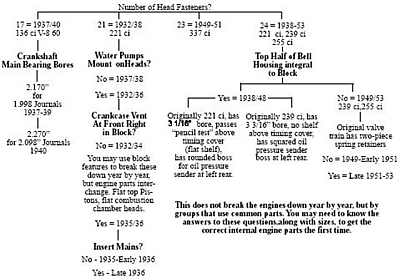What should you do first when you have an engine and you are thinking about rebuilding it? How about buying pistons? Well, let’s slow down here and take a look at your project.
Chart To Begin Your Engine BuildingBeware of using features that may have been changed to identifythe year range of your engine. Examples are heads, head bolts vs. studs and nuts, pistons, crankshafts, rods, timing covers, water pumps and bore size.
The following will determine year range:

Do you know what vehicle you are going to put this engine into? Are you going to have this vehicle judged? Is the engine you have correct for this application? If you question that, ee the attached chart and ask the Early Ford V8 Club advisor for your vehicle.
If you are not going to have the vehicle judged to Early Ford V8 Club standards, then the exact year of your engine matters less, but you still need to know some of its features to get the correct engine parts.
You also need to look at your intended use for the engine. If you are going to use it in any kind of racing, read the rule book that the race organizers supply. You may get extra credit for an engine that is at least externally appears older – an example is The Great Race rules. Another example is that the Bonneville Nationals don’t allow French blocks. Get all of this information before you select and build and engine.
When you have selected an engine that is of the best year, or year range, for your purposes, what’s next?
If it is not already apart, take it apart completely. Make a visual inspection as you go. Take out the oil gallery plugs.
Take the block to a machine shop that has the ability to get the block completely clean. Then have them, or someone that you trust, do a rigorous magnetic particle inspection for cracks in the block.
Maybe it will have some cracks; some can be repaired economically, some cannot. Some of the cracks between water passages and stud holes don’t need to be repaired. Cracks in combustion chambers are more serious than those in other areas. Especially if you are building an engine for higher performance, be wary of combustion chamber cracks.
Don’t go away, we’re getting close to ordering those pistons.
Hopefully, you now have a block that you are satisfied with: it is either not cracked or there are cracks but you have confidence in the proposed repairs to them.
Now it is time to measure the bores. If possible have this done with a dial bore gauge. With a dial bore gauge much of bore areas can be surveyed with good accuracy and without lots of invested time in the measuring.
So let’s say that the survey of the bores shows unworn areas at 3.218” with the worst wear of .022”. What does that mean to you?
If you have a block that started with 3 1/16” bores, it means that it is already “to the max” and maybe you should not rebuild it. If it is originally 3 3/16” (3.1875) bore block, it means that it is at .030” and has .022” wear. So, order pistons at +.060”?
Probably not. The rule of thumb is to divide the worst wear by .7, then round up to get the amount of additional oversize required.
Why is that? An additional .030” should cover wear of .022” shouldn’t it? The reason is that the cylinder wear is not round or straight. So you can see the potential problems here. With these numbers, I wouldn’t bank on the bores cleaning up at +.060”, but +.080” should do the trick.
If it is really important to you to have the smallest bores possible, consider asking the machine shop to pre-bore the most worn cylinder(s) before the pistons are ordered. This could save time and money in the long run.
What about rust in the bores? Many of the engines that we are rebuilding have been sitting out of use for years, maybe decades. If the air cleaner was off and rain went down the carburetor, there will probably be at least two rusty cylinders. If one or both heads were off, maybe all the cylinders will be rusty.
This is another time when pre-boring is the way to go. If the rust is from atmospheric moisture it will probably not be as bad as from water standing in the bore. You may find it best to sleeve one or two bores that have had water in them, especially if you are trying to limit final bore size.
Sleeving all bores on one bank of the V8 cylinders adds some risk. The bores cast in the block add some structural strength to the block, tying the top deck and the bottom of the block together. The sleeves are good for containing the combustion pressure in the cylinder, but they don’t add much strength to the deck. The result can be head gaskets that blow due to deck flexibility.
I hope this is helpful to those of you approaching this part of your restorations and projects.
Red welcomes your comments and suggestions:
Red Hamilton,
